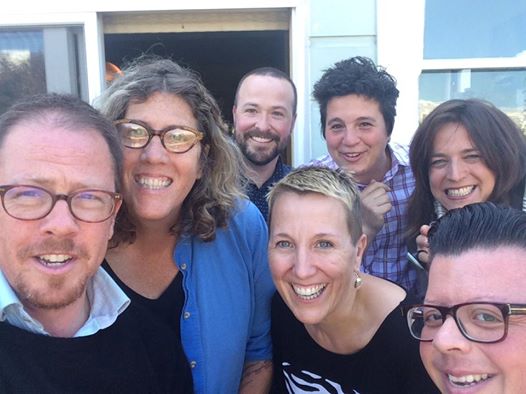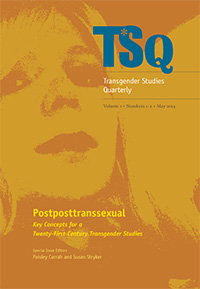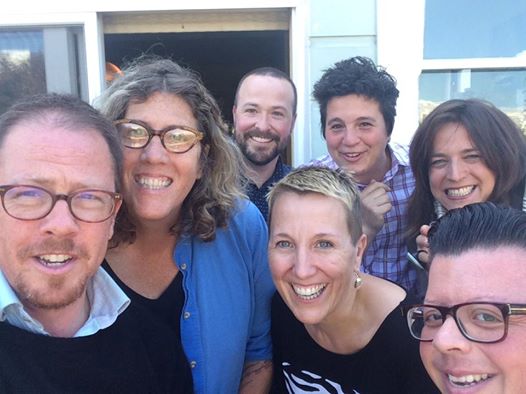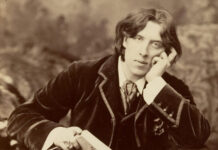_____________________________________________________________________________________
Petra Dierkes-Thrun interviews Susan Stryker, leader of an unprecedented initiative in transgender studies at the University of Arizona, and one of two founding co-editors of the new journal TSQ: Transgender Studies Quarterly (together with Paisley Currah). Stryker is Associate Professor of Gender and Women’s Studies, and Director of the Institute for LGBT Studies at the University of Arizona. The author or editor of numerous books and articles on transgender and queer topics for popular and scholarly audiences alike, she won an Emmy Award for the documentary film Screaming Queens: The Riot at Compton’s Cafeteria, a Lambda Literary Award for The Transgender Studies Reader, and the Ruth Benedict Book Prize for The Transgender Studies Reader 2.
_____________________________________________________________________________________

DIERKES-THRUN: The University of Arizona recently initiated an unprecedented cluster hire in transgender studies and is actively working towards a graduate degree program in transgender studies. Can you tell us a bit more about the history and the thinking behind this strong, coordinated move at your institution?
STRYKER: After the University of Arizona (UA) recruited me away from my previous job to direct the Institute for LGBT Studies in 2011, I came in saying that I wanted to put equal emphasis on the “T” in that acronym, and they were supportive of that. But none of us anticipated that the T was going to become the tail that wagged the dog, so to speak. It would not have happened had I not been courted by another, much more prestigious university during my second year on the job. UA asked what it would take to retain me, and I said I wanted to do something unprecedented, something I would not be able to do at that other university, something that would transform my field, while also putting UA on the map in a bold new way. I said I wanted to launch a transgender studies initiative, which represents my vision of the field’s need to grow. The institution said yes to what I proposed, and to the upper administration’s credit, they saw an opportunity in what I pitched.
The truly unprecedented institutional commitment came in the form of strategic hiring support for a transgender studies faculty cluster. As UA has been quick to point out to conservative critics of this initiative, no new funds were identified to create these faculty lines—they came from existing pools of discretionary funds, and represent a shifting towards emerging areas of study of faculty lines freed up by retirement or resignation. That said, no university anywhere in the world has ever conducted a faculty cluster hire in transgender studies. Four lines were made available: two in the College of Social and Behavioral Sciences, and two in colleges elsewhere in the University. We wound up filling three of those positions last year—hiring in medical anthropology, feminist science and technology studies, and religious studies—and are in negotiations about where to place the remaining line.
UA has a strong institutional culture of interdisciplinary collaboration, as well as a good track record of supporting LGBT issues, so this fit right in. They understand that transgender issues have a lot of cultural saliency at the moment, and that studying the rapid shifts in contemporary gender systems, including the emergence of historically new forms of gender expression, particularly in the context of the biomedical technologization of “life itself,” is a legitimate field of study and research. Pragmatically, they saw the initiative as a way to attract and retain innovative and diverse faculty members, to bring in out-of-state tuition dollars, to compete for external research grants, and to push back against the popular misconception that Arizona is only a politically reactionary place. From the institution’s perspective, there was no advocacy agenda at work here, just an opportunity to increase the bottom line by building on existing faculty and research strengths.
The lowest-hanging fruit, which can be accomplished with relatively little bureaucracy, is a graduate concentration, minor, or designated emphasis in transgender studies, and there is definitely support for that. We hope to have that in place within a year. It is also possible that a currently existing MA program in Gender and Women’s Studies could be adapted relatively easily to accommodate a transgender studies emphasis, but that involves a lot of inside-the-ballpark negotiation with current GWS faculty. Actually creating a new, stand-alone graduate program at the state’s land grant university would require approval by the Arizona Board of Regents, and ultimately by the Governor’s Office, so that will be a longer and tougher row to hoe.
The final element of the initiative is approval to pursue establishing a new research enterprise called the “Center for Critical Studies of the Body.” The rationale here was to provide a non-identitarian rubric that could bring transgender studies into dialog with other interdisciplinary fields, such as the study of disability, trauma, sports, medical humanities, etc. No funds were provided for this, just a green light for starting the process of cobbling a center together.
Of course, it’s vital to ask the question why, in an era when the teaching of Chicano/a studies is literally being outlawed in Arizona public schools, when xenophobic attitudes inform the state’s border politics, attention to transgender identities and practices can appear palatable. How does institutional investment in transgender studies at this particular historical juncture play into a deep logic of “managing difference” through expert knowledges, or get positioned as less threatening than calls for racial and economic justice? As the person heading up this initiative, I want to be attentive to ways I can use trans studies to advance other concerns that currently have a harder time getting traction in Arizona. I think my deepest challenge in trying to spearhead this initiative lies in resisting the ways that transgender studies can be co-opted for neoliberal uses that fall short of its radical transformative potential.
DIERKES-THRUN: The University of Arizona also provided financial and logistical support for the establishment of a new journal of record for the field of transgender studies, TSQ: Transgender Studies Quarterly, published by Duke University Press in 2014, with you and Paisley Currah (Professor of Political Science at Brooklyn College and the CUNY Graduate Center) as founding co-editors. How did that come about?
STRYKER: Launching this journal had been a long-term project of mine and Paisley’s and was already well underway before the opportunity to launch the broader transgender studies initiative came up, but it nevertheless constitutes an important element of what has become the bigger project. UA has significantly supported the establishment of TSQ by contributing about one-third of the start-up costs. Those funds were cobbled together from a lot of different institutional sources, including the Provost’s Office, the office of the Vice President for Research, the College of Social and Behavioral Sciences, the Department of Gender and Women’s Studies, and the Institute for LGBT Studies.
DIERKES-THRUN: For our readers who are just now becoming acquainted with transgender studies as a diverse intellectual and academic field, how would you summarize its most important constants and changes over the past two decades? What are some important subareas and affiliated fields for transgender studies?
STRYKER: I’d recommend taking a look at the tables of contents in the two volumes of The Transgender Studies Reader. The first volume, from 2006, offers a genealogy of field formation, highlighting historical ties to scientific sexology, feminism, and poststructuralist theory.
It includes work from the “transgender moment” of the early 1990s that changed the conversation on trans issues and tackles many of the topics that were of interest in the field’s first decade—questions of self-representation, diversity within trans communities, the increasing visibility of trans-masculinities. The second volume, from 2013, showcases the rapid evolution of the field in the 21st century, which is self-consciously moving in strongly transnational directions away from the Anglophone North American biases of the field’s first decade. There has been much more attention paid to the relationship between transgender issues and other structural forms of inequality and injustice, and, post 9/11, to questions about borders, surveillance, and security—and the ways that non-conventionally gendered bodies experience heightened scrutiny and limitations on movement, and can be seen as posing a terroristic threat to the body politic. There are increasing affinities with posthumanist work, as well as with animal studies, critical life studies, and the so-called “new materialism.” The first several issues of TSQ suggest something of current directions in the field: they address decolonization, cultural production, population studies, transanimalities, higher education studies, archives, transfeminism, political economy, sex classification, translation, surgery, sinophone studies, and psychoanalytic theory.
DIERKES-THRUN: Can you say something about the trans- and international context of transgender studies today? What are the most important challenges there and why should we be thinking about them?
STRYKER: The field has indeed been moving in a strongly transnational direction for more than a decade. I was particularly pleased that The Transgender Studies Reader 2 was awarded the 2013 Ruth Benedict Prize from the Association for Queer Anthropology/American Anthropological Association, precisely because the field of transgender studies challenges us to think anew about how we understand sex/gender/identity cross-culturally. I think one of the biggest intellectual challenges has to do with fully acknowledging that some of the fundamental categories that we use to understand “human being”—like man and woman—are not ontologically given, but rather are themselves historically and cultural variable and contingent. Translation is also a huge problem—how do we facilitate the exchange of knowledge across language and culture, when the very categories we use to organize and recognize our own being and that of others can be so deeply incommensurable?
DIERKES-THRUN: In the introduction to the inaugural issue of TSQ, the editors write, “Transgender studies promises to make a significant intellectual and political intervention into contemporary knowledge production in much the same manner that queer theory did twenty years ago.” What are some of the most needed intellectual and political interventions that you anticipate transgender studies can and will make?
 STRYKER: First and foremost, I see it creating more space for critical conversations that involve transgender speakers. Bringing trans studies into the academy is one way of bringing more trans people into the academy. Of course I’m not arguing that trans studies is something that on trans people can participate in. Far from it—anybody can develop an expertise in this area, or feel that they have some sort of stake in it. But just as disability activists said in the 70s and 80, “nothing about us without us.” What’s most significant is creating an opportunity for the privileged and powerful kinds of knowledge production that takes place in the academy (about trans topics or any other area that involves people) to be not just objectifying knowledge, what we might call “knowledge of,” but also “knowledge with,” knowledge that emerges from a dialog that includes trans people who bring an additional kind of experiential or embodied knowledge along with their formal, expert knowledges. It’s the same rationale for any kind of diversity hiring initiative. People have different kinds of “situated knowledges” that derive from how they live their bodily differences in the world. It’s important to have people in critical conversations who come from different perspectives based on race/ethnicity, gender, ability, national origin, first languages, etc. Transgender represents a different kind of difference that offers a novel perspective on how gender systems, and therefore society, work.
STRYKER: First and foremost, I see it creating more space for critical conversations that involve transgender speakers. Bringing trans studies into the academy is one way of bringing more trans people into the academy. Of course I’m not arguing that trans studies is something that on trans people can participate in. Far from it—anybody can develop an expertise in this area, or feel that they have some sort of stake in it. But just as disability activists said in the 70s and 80, “nothing about us without us.” What’s most significant is creating an opportunity for the privileged and powerful kinds of knowledge production that takes place in the academy (about trans topics or any other area that involves people) to be not just objectifying knowledge, what we might call “knowledge of,” but also “knowledge with,” knowledge that emerges from a dialog that includes trans people who bring an additional kind of experiential or embodied knowledge along with their formal, expert knowledges. It’s the same rationale for any kind of diversity hiring initiative. People have different kinds of “situated knowledges” that derive from how they live their bodily differences in the world. It’s important to have people in critical conversations who come from different perspectives based on race/ethnicity, gender, ability, national origin, first languages, etc. Transgender represents a different kind of difference that offers a novel perspective on how gender systems, and therefore society, work.
DIERKES-THRUN: You also say, in the same TSQ introduction, that transgender studies “offers fertile ground for conversations about what the posthuman might practically entail (as well as what, historically, it has already been).” The posthuman is a topic of interest to many of our readers. Could you map out for us what specific or broader contributions transgender studies can make to past and future discussions of the posthuman?
STRYKER: The first thing we say of a new child is “It’s a girl” or It’s a boy.” Through the operation of language, we move a body across the line that separates mere biological organism from human community, transforming the status of a nonhuman “it” into a person through the conferral of a gender status. It has been very difficult to think of the human without thinking of it through the binary gender schema. I think a lot of the violence and discrimination trans people face derives from a fundamental inability on the part of others to see us as fully human because we are considered improperly gendered, and thus lower on the animacy hierarchy, therefore closer to death and inanimacy, therefore more expendable and less valuable than humans. A transgender will to life thus serves as a point from which to critique the human as a universal status attributed to all members of the species, and to reveal it instead as a narrower set of criteria wielded by some to dehumanize others.
DIERKES-THRUN: The journal description announces that TSQ “will publish interdisciplinary work that explores the diversity of gender, sex, sexuality, embodiment, and identity in ways that have not been adequately addressed by feminist and queer scholarship.” What have been some of feminist and queer theory’s most important blind spots when it comes to thinking about the transgender experience?
STRYKER: Transgender Studies emerged as an interdisciplinary field in the early 1990s, at roughly the same time as queer theory. There’s been a robust conversation about the relationship between the two, especially given the simultaneous formation of what’s come to be called the “LGBT” community. I contend that trans studies, as it was first articulated, shared an agenda with queer studies in the sense that it critiqued heteronormative society from a place of oppositional difference. It argued that “queer” was not just a five letter word for homosexual, but rather that queer encompassed a range of “different differences” that all had a stake in contesting various sorts of oppressive and coercive normativities related to sex, sexuality, identity, and embodiment. As queer theory developed, however, issues of sexuality really did remain in the forefront. From a transgender studies perspective, the whole distinction between homo and hetero sexualities depends on a prior agreement about what constitutes “sex,” on who’s a man and who’s a woman. Destabilizing those material referents, or needing to account for their sequentiality, their fuzzy boundaries, their historicity or cultural specificity, or their hybridity really opens up a whole different set of questions. In addition, trans studies is not organized primarily around issues of sexuality; equally important are questions of gender, bodily difference, heath care provision, technology studies, and a host of other things that have not been central to queer studies. So the debate between queer and trans studies has been about whether they are different parts of the same big intellectual and critical project, employing the same transversal methodologies for bringing into analytical focus and contesting oppressive normativities, or whether they overlap with one another—sharing some interests but not others—or whether they are really two different enterprises, concerned with different objects of study.
My personal answer is all of the above, sometimes. At its most radical, trans studies offers a critique of the ways in which gay and lesbian liberation and civil rights struggles have advanced themselves by securing greater access to citizenship for homosexuals precisely through the reproduction of gender normativities—the liberal “I’m just like a straight person except for who I have sex with” argument. What actually provides the commonality there between homo and hetero is an agreement about who is a man and who is a woman, and how we can tell the difference between the two. Trans studies puts pressure on that tacit agreement.
With regard to feminism, I think the major innovation transgender studies offers has to do with how gender hierarchies operate. In the most conventional feminist frameworks, what has seemed most important is to better understand and thereby better resist the subordination of women to men. Without contesting that basic tenet, transgender studies suggests that it is also necessary to understand how contesting the hierarchized gender binary itself can increase vulnerabilities to structural oppression for those people who don’t fit in, or who refuse to be fixed in place. That is, in addition to needing to address power structures that privilege normatively gendered men and masculinity over normatively gendered women and femininity, we also need to address a wide range of gender nonnormativities, atypicalities, transitivities, and fluidities. I see this as extending, rather than challenging, fundamental feminist insights.
DIERKES-THRUN: Many of our readers may not know this, but traditionally, the relationship between queer theory and transgender studies and activism has been quite contentious. Is the fact that there is now a separate academic journal for trans studies indicative of an ongoing divide with queer studies, despite what you call the recent “transgender turn”?
STRYKER: There’s a big enough and deep enough conversation on trans topics to merit and sustain an independent journal for the field, that’s all. There is more publishable scholarship on trans issues and topic than will ever fit into GLQ, given that journal’s broader scope, or that can ever fit into one-off special issues of disciplinary or interdisciplinary journals devoted to trans topics. Worrying that the advent of TSQ signals a divergence or parting of the ways between queer and trans studies is an overblown concern. Personally, I’d hate to see queer and trans studies drift further apart, because I feel strongly committed to both. I think trans studies is expansive enough to encompass a lot of queer scholarship on sex/gender nonnormativity, while also advancing scholarship on transgender-related topics that queer studies has never been particularly interested in.
DIERKES-THRUN: As someone who has worked as a historian, social activist for trans rights and documentary filmmaker on trans history, how would you describe the state of our society’s understanding and attitudes towards transgender today? Does it feel like the tide has finally shifted?
STRYKER: I think it is a mixed bag. Pretty much everybody today knows that there is this thing called “transgender”, but they can’t say exactly what it is. They know if they want to be considered progressive they are supposed to be OK with it, even if they secretly feel squeamish or judgmental or confused. That’s an improvement over the situation in decades past, when pretty much everybody agreed that there were these sick people and freaks and weirdoes who wanted to cross-dress or take hormones or cut up their genitals, but they were not important, and society really didn’t have to pay any attention to such a marginal and stigmatized phenomenon. So yes, there has been a shift, but yes, there is still a long way to go.
DIERKES-THRUN: Which projects are you working on now?
STRYKER: I have a really heavy administrative load right now. I was already trying to run a research institute, teach, commute between my job in Tucson and my home in San Francisco, and launch a new peer-reviewed journal, before the trans studies initiative became a possibility. That has definitely been a “be careful what you ask for” lesson, in terms of workload. I feel like I don’t write anything these days that doesn’t start with the words “Executive Summary” and end with the words “Total Budget.” It will probably be like that for a couple more years, especially until I complete my agreed-upon term of service as director of the Institute for LGBT Studies at the end of 2016.
But there are a couple of projects percolating along on the back burner. At the time I came to Arizona, I was working on an experimental media project called Christine in the Cutting Room, about the 1950s transsexual celebrity Christine Jorgensen, who burst onto the global stage when news of her sex-change surgery made headlines around the world. The project was sparked for me by a comment Jorgensen made in an interview with television journalist Mike Wallace. She was talking about her pre-fame job as a film cutter in the newsreel division at RKO Studios in New York, and said that she “used to work on one side of the camera” because she “didn’t know how to appear on the other side.” That gave me the idea of approaching the question of transsexuality from an aesthetic perspective, as a technique of visualization, accomplished through media manipulation. I saw Jorgensen using cinematic techniques of media cutting, suturing, image creation, and projection to move her from one side of the camera to the other, by moving herself from one kind of “cutting room” to another. I have always been interested in ways of exploring trans experience outside the pervasive psychomedical framework, and this project lets me do that. I mix archival audiovisual media of Jorgensen herself, found sound and images, electronic glitch music, and a scripted voice-over narration performed by an actress playing Jorgensen. At some point I hope to edit this material into a narrative film, but I have found it also works well as a multimedia installation in galleries and clubs.
I am also trying to write a book. I’ve finally hit on a way to piece together into one overarching argument lots of fragments of abandoned or incomplete projects on embodiment and technology, the early Mormons, members of San Francisco’s elite Bohemian Club, transsexuals, urban history, and popular music. My working title is Identity is a War Machine: The Somatechnics of Gender, Race, and Whiteness. It’s about the processes through which we incorporate—literally somaticize—culturally specific and historically revisable categories of individual identity within biopolitical regimes of governmentality. I won’t say any more about it at this time, because this book itself could be one of my many unfinished projects.
DIERKES-THRUN: Transgender as a topic of public curiosity seems to be everywhere in U.S. media culture these days, from Laverne Cox and Orange Is the New Black to Chelsea Manning, Andreja Pejic and others. (There is also a lot of naïve conflation with drag and cross-dressing, as the media treatment of Conchita Wurst illustrates.) Do you worry about the glamorization and commodification of certain kinds of trans bodies in the media and the silence around others? Are famous celebrity spokespeople like Laverne Cox or Janet Mock good or bad for the movement, from your perspective?
STRYKER: In the wake of the repeal of the U.S. military’s Don’t-Ask-Don’t-Tell policy regarding homosexual service members, and after the Supreme Court decisions on marriage equality, transgender has emerged in some quarters as the “next big thing” in minority rights. I have a lot of problems with that way of framing things, and am very leery of the ways that story functions as a neoliberal progress narrative, and of the ways in which protecting trans people (now that gays have been taken care of) can exemplify the values of inclusivity and diversity, so that the US or the West can use support for trans rights to assert influence over other parts of the world who purportedly do not do as good a job on this front. What is truly amazing to me, after having been out as trans for nearly a quarter century, is the extent to which it is now becoming possible for some trans people to access what I call “transnormative citizenship,” while at the same time truly horrific life circumstances persist for other trans people. Race really does seem to be the dividing line that allows some trans people to be cultivated for life, invested in, recognized, and enfolded into the biopolitical state, while allowing others to be consigned to malignant neglect or lethal violence. The contemporary celebrity culture of transgender plays to both sides of this dichotomy. It’s increasingly possible to see trans people represented as successful, beautiful, productive, or innovative (and I salute those trans people who have accomplished those things). At the same time, you see people like Laverne Cox and Janet Mock using their platform to call attention the persistence of injustices, particularly for trans women of color. I am truly inspired by the way they both speak out on race, classism, the prison-industrial complex, and sex-work.





[…] Some interesting things going on at the University of Arizona, my alma mater: “Transgender Studies Today: An Interview with Susan Stryker.” […]
Reblogged this on Tracey Yeadon-Lee and commented:
This is a great interview with Susan Stryker, one of the leading lights in trans studies. She gives a great overview of past and current trends in the field and commenting on the relevance of trans studies to feminism and feminist concerns, she says that we ‘need to address a wide range of gender nonnormativities, atypicalities, transitivities, and fluidities. I see this as extending, rather than challenging, fundamental feminist insights’ .
[…] https://www.boundary2.org/2014/08/20/transgender-studies-today-an-interview-with-susan-stryker/ […]
[…] https://www.boundary2.org/2014/08/20/transgender-studies-today-an-interview-with-susan-stryker/ […]
Reblogged this on Literature Illuminations and commented:
My interview with Susan Stryker for boundary2.
Reblogged this on transatlantictransadvocates and commented:
This seems to be a very positive thing to be happening in the States towards getting us “tail waggers” out of the shadows. I ordered both volumes of the TRANSGENDER STUDIES READER. and the TSQ free issue is on my reading schedule.
On my FACEBOOK page I have some recent posts of LGBT things going on in Europe, and I am reading a Master’s thesis from Lund University in Sweden dealing with Gender Identity As a Right in cases before the EU Court.
[…] Susan Stryker, docente di studi di genere e studi sulle donne, oltre che storica del transgenderismo (?), puntualizza come la fonte del film sia un romanzo e non un lavoro di non-fiction. […]
[…] [2] https://www.boundary2.org/2014/08/transgender-studies-today-an-interview-with-susan-stryker/ […]